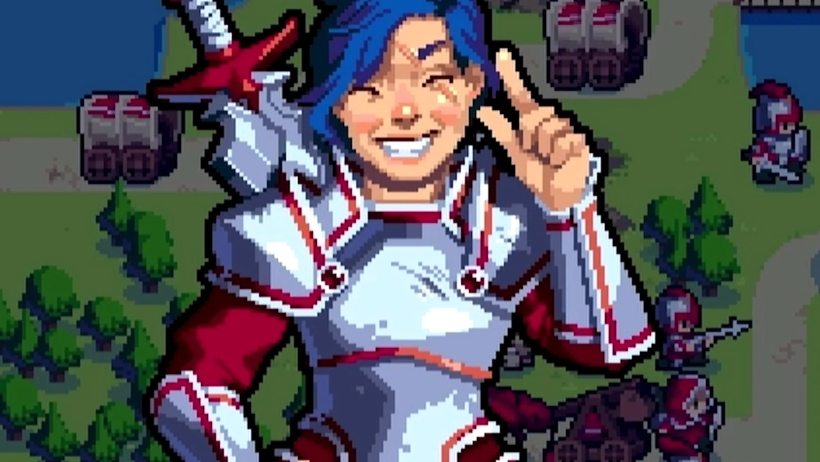Wargroove: Guide (PC, Xbox and Nintendo Switch)
Our guide to the Advance Wars-inspired turn-based strategy game
Our Wargroove guide for PC, Xbox and Nintendo Switch covers factions, commanders, units and grooves. Strategy tips will be added at launch.
If you’ve found yourself waiting far too long for a new Advance Wars title, then we’re pretty sure that Wargroove is going to scratch that itch when it launches in February 2019.
This turn-based strategy game for up to four players makes plenty of nods to its obvious inspiration, while also adding an extra bit of polish to those retro visuals. There’s online and local competitive multiplayer too.
In our guide to getting started with Wargroove, we’ve gathered together all of the information we currently have about it.
In future updates, and once we’ve actually played the game for ourselves, we’ll be bringing you more insightful guide content, with a particular focus on the competitive multiplayer aspect.
Until then, here’s what you need to know about ahead of launch.

Platforms
Wargroove will be available for the Xbox One, PC and Switch platforms. A PlayStation 4 version will also be launched later in 2019.
Release Date
Wargroove will be released on 1st February on Nintendo Switch, PC and Xbox One. The PlayStation 4 version of the game has yet to be dated but is expected to launch at some point in 2019.
Gameplay Overview
As we’ve mentioned earlier on in our guide, Wargroove is a turn-based game where you fight against one or more AI or human opponents.
Gameplay takes place across a map that is separated into tiles. Onto this map you field and manipulate units which are capable of moving so many tiles on a given turn, or performing certain actions.
The objective is to out-fox your opponent by setting up superior defensive and offensive plays, and ultimately eliminate all of their units by doing so.
There may be other win-conditions involved during the single-player campaign, but that’s a rough explanation of what’s involved.
Commanders and Factions
There are a number of different factions in Wargroove, each one of which has its own commander and collection of figthing units. Here’s a snapshot of the commanders for each faction:
- Cherrystone Kingdom: Mercia, Emeric, Caesar
- Felheim Region: Valder, Ragna, Sigrid
- Floran Tribes: Greenfinger, Nuru, Sedge
- Heavensong Empire: Tenri, Koji, Ryota
Grooves
Each of the commanders that we’ve outlined in the section above has their own “groove”, hence the game’s name. Here’s what each commander can exploit to make life a little easier:
Note that each commander has something called a groove meter. It needs to be charged to 100% before it can be activated, and using the groove sets the meter back to 0%.
| Faction | Commander | Groove |
|---|---|---|
| Cherrystone Kingdom | Mercia | Heal Aura: Heal all units in a large radius |
| Emeric | Cherrystone Defense: Deploy a Cherrystone and add defense to all nearby allied units | |
| Caesar | Inspire: All adjacent targets can attack again this turn | |
| Felheim Legion | Valder | Raise Dead: Create a friendly adjacent unit that can attack immediately. |
| Ragna | Shield Jump: Teleport to a tile within five tiles. Deal 5 damage to adjacent units after landing | |
| Sigrid | Vampric Touch: Drain health from a target and restore health to Sigrid | |
| Floran Tribes | Greenfinger | Wild Growth: Create vines that block enemy movement. Vines decay over time and can be attacked. |
| Nuru | Teleport Beam: Teleport a friendly unit beside Nuru. | |
| Sedge | Sadistic Rush: Strike a target for 35% damage. Groove is recharged if the target dies | |
| Heavensong Empire | Tenri | Tornado: Move an allied or enemy target to another nearby location |
| Koji | Sparrow Bombs: Spawn two Sparrow Bombs which can immediately move 5 tiles and detonate to damage enemies | |
| Ryota | Blade Dash: Dash through multiple enemies and deal damage to them. |
Units
There are a number of different units you can make use of in Wargroove, each of which has its own costs, movement scope and special abilities.
Each faction can make use of its own special units as well, but in general they can broadly be separated into land, air and sea units. As the names suggest, each unit type has its own situational value.
In a future update to our Wargroove guide, we’ll be adding in detailed information about each unit in the game.
Multiplayer
As well as a generous single-player campaign, there’ll also be competitive mulitplayer modes to tackle in Wargroove too.
- Local Multiplayer: Up to four players can compete locally by sharing the controller turn by turn. With fog of war enabled, you’ll be able to hide what you’ve been up to before handing the controller over to your friend!
- Online: You’ll also be able to compete with other players over the internet, with fully customisable rulesets and maps. You’ll presumably be able to compete against people on your friends list, or with the Wargroove community at large.
Controls
Here are the control systems that have been confirmed for both keyboard and mouse, and for the Xbox controller:
Keyboard and Mouse Controls
- WASD – Move camera left, right, up and down
- Left Click / Enter – Move characters and select other options
- Right Click / Space – Bring up information on the target unit, building or tile
Xbox Controls
- DPad / Left Joystick – Move cursor or unit
- Right Joystick – Move camera around the screen
- Start – End Turn or access the menu
- A – Select actions
- B – See information on the target unit, building or tile
